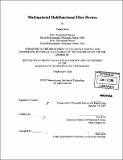Multimaterial multifunctional fiber devices
Author(s)
Sorin, Fabien
DownloadFull printable version (43.69Mb)
Other Contributors
Massachusetts Institute of Technology. Dept. of Materials Science and Engineering.
Advisor
Yoel Fink.
Terms of use
Metadata
Show full item recordAbstract
Optical fibers and semiconductor devices differ significantly in their properties and their processing approaches. The latter require an assembly of metal, insulator and semiconductor materials into complex geometries with small feature sizes (sub 100 nm), while maintaining high quality interfaces. Sophisticated logic and detection functions are realized through the integration of many such devices onto a chip. Conventional optical fibers have been restricted to insulating materials, much simpler cylindrically symmetric structures and larger feature sizes (order of a micrometer). Consequently a single fiber operates as a single optical transport device. Indeed the notion of integration has been foreign to optical fibers. Their processing however is much simpler compared to semiconductor devices as it utilizes a macroscopic perform to microscopic fiber fabrication approach. This process can efficiently yield highly uniform long and flexible fibers amenable to the formation of large area assemblies and woven fabrics. In this thesis, it is established that in-principle sophisticated semiconductor devices can be produced using simple preform-to-fiber thermal drawing techniques: In the first chapter a new materials processing paradigm is introduced where for the first time metals, insulators and semiconductors are thermally co-drawn in intimate contact and prescribed geometries. The second chapter focuses on unifunctional fiber devices and in particular the unique features of ID distributed photodetecting fibers. The concept of fiber device integration is then established by demonstrating optic, electronic and optoelectronic functionalities within a single fiber. In a third chapter a model for understanding the influence of geometric and structural changes on the performance of fiber photodetectors is derived. (cont.) It is demonstrated in particular that similarly to the evolution of semiconductor devices, the reduction of the materials feature dimensions inside the fiber significantly impacts the fiber performance characteristics. This in turn enables an increase in device density integrated into a single fiber. Unprecedented angular and spectral resolutions are achieved using this approach as described in chapter four. Finally, the first field effect is observed in a thermally drawn semiconductor metal insulator fiber. This paves the way to further integration of ever more complex electronic functionalities inside fiber devices.
Description
Thesis (Ph. D.)--Massachusetts Institute of Technology, Dept. of Materials Science and Engineering, 2008. Includes bibliographical references (p. 125-129).
Date issued
2008Department
Massachusetts Institute of Technology. Department of Materials Science and EngineeringPublisher
Massachusetts Institute of Technology
Keywords
Materials Science and Engineering.